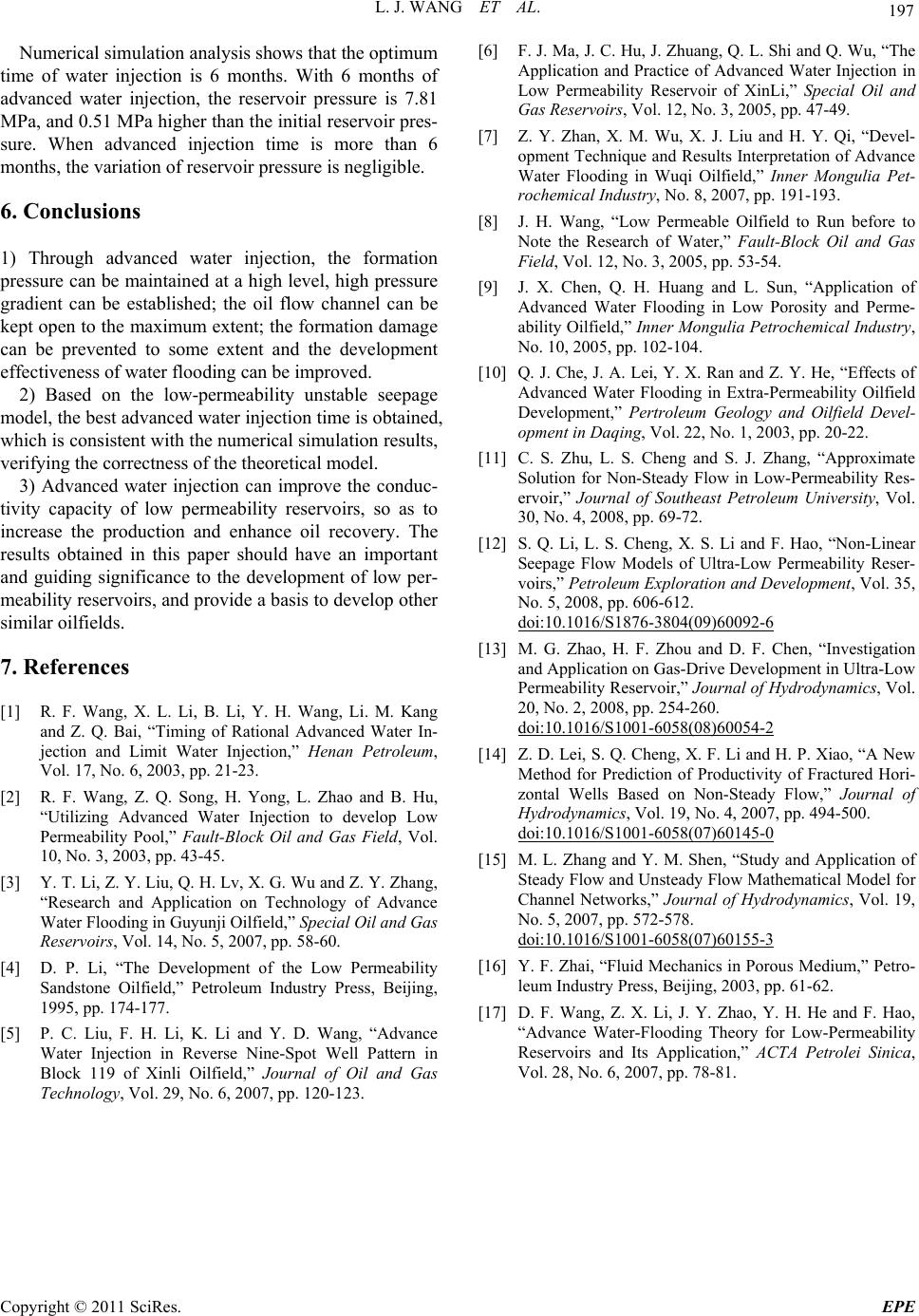
L. J. WANG ET AL.
Copyright © 2011 SciRes. EPE
197
Numerical simulation analysis shows that the optimum
time of water injection is 6 months. With 6 months of
advanced water injection, the reservoir pressure is 7.81
MPa, and 0.51 MPa higher than the initial reservoir pres-
sure. When advanced injection time is more than 6
months, the variation of reservoir pressure is negligible.
6. Conclusions
1) Through advanced water injection, the formation
pressure can be maintained at a high level, high pressure
gradient can be established; the oil flow channel can be
kept open to the maximum extent; the formation damage
can be prevented to some extent and the development
effectiveness of water flooding can be improved.
2) Based on the low-permeability unstable seepage
model, the best advanced water injection time is obtained,
which is consistent with the numerical simulation results,
verifying the correctness of the theoretical model.
3) Advanced water injection can improve the conduc-
tivity capacity of low permeability reservoirs, so as to
increase the production and enhance oil recovery. The
results obtained in this paper should have an important
and guiding significance to the development of low per-
meability reservoirs, and provide a basis to develop other
similar oilfields.
7. References
[1] R. F. Wang, X. L. Li, B. Li, Y. H. Wang, Li. M. Kang
and Z. Q. Bai, “Timing of Rational Advanced Water In-
jection and Limit Water Injection,” Henan Petroleum,
Vol. 17, No. 6, 2003, pp. 21-23.
[2] R. F. Wang, Z. Q. Song, H. Yong, L. Zhao and B. Hu,
“Utilizing Advanced Water Injection to develop Low
Permeability Pool,” Fault-Block Oil and Gas Field, Vol.
10, No. 3, 2003, pp. 43-45.
[3] Y. T. Li, Z. Y. Liu, Q. H. Lv, X. G. Wu and Z. Y. Zhang,
“Research and Application on Technology of Advance
Water Flooding in Guyunji Oilfield,” Special Oil and Gas
Reservoirs, Vol. 14, No. 5, 2007, pp. 58-60.
[4] D. P. Li, “The Development of the Low Permeability
Sandstone Oilfield,” Petroleum Industry Press, Beijing,
1995, pp. 174-177.
[5] P. C. Liu, F. H. Li, K. Li and Y. D. Wang, “Advance
Water Injection in Reverse Nine-Spot Well Pattern in
Block 119 of Xinli Oilfield,” Journal of Oil and Gas
Technology, Vol. 29, No. 6, 2007, pp. 120-123.
[6] F. J. Ma, J. C. Hu, J. Zhuang, Q. L. Shi and Q. Wu, “The
Application and Practice of Advanced Water Injection in
Low Permeability Reservoir of XinLi,” Special Oil and
Gas Reservoirs, Vol. 12, No. 3, 2005, pp. 47-49.
[7] Z. Y. Zhan, X. M. Wu, X. J. Liu and H. Y. Qi, “Devel-
opment Technique and Results Interpretation of Advance
Water Flooding in Wuqi Oilfield,” Inner Mongulia Pet-
rochemical Industry, No. 8, 2007, pp. 191-193.
[8] J. H. Wang, “Low Permeable Oilfield to Run before to
Note the Research of Water,” Fault-Block Oil and Gas
Field, Vol. 12, No. 3, 2005, pp. 53-54.
[9] J. X. Chen, Q. H. Huang and L. Sun, “Application of
Advanced Water Flooding in Low Porosity and Perme-
ability Oilfield,” Inner Mongulia Petrochemical Industry,
No. 10, 2005, pp. 102-104.
[10] Q. J. Che, J. A. Lei, Y. X. Ran and Z. Y. He, “Effects of
Advanced Water Flooding in Extra-Permeability Oilfield
Development,” Pertroleum Geology and Oilfield Devel-
opment in Daqing, Vol. 22, No. 1, 2003, pp. 20-22.
[11] C. S. Zhu, L. S. Cheng and S. J. Zhang, “Approximate
Solution for Non-Steady Flow in Low-Permeability Res-
ervoir,” Journal of Southeast Petroleum University, Vol.
30, No. 4, 2008, pp. 69-72.
[12] S. Q. Li, L. S. Cheng, X. S. Li and F. Hao, “Non-Linear
Seepage Flow Models of Ultra-Low Permeability Reser-
voirs,” Petroleum Exploration and Development, Vol. 35,
No. 5, 2008, pp. 606-612.
doi:10.1016/S1876-3804(09)60092-6
[13] M. G. Zhao, H. F. Zhou and D. F. Chen, “Investigation
and Application on Gas-Drive Development in Ultra-Low
Permeability Reservoir,” Journal of Hydrodynamics, Vol.
20, No. 2, 2008, pp. 254-260.
doi:10.1016/S1001-6058(08)60054-2
[14] Z. D. Lei, S. Q. Cheng, X. F. Li and H. P. Xiao, “A New
Method for Prediction of Productivity of Fractured Hori-
zontal Wells Based on Non-Steady Flow,” Journal of
Hydrodynamics, Vol. 19, No. 4, 2007, pp. 494-500.
doi:10.1016/S1001-6058(07)60145-0
[15] M. L. Zhang and Y. M. Shen, “Study and Application of
Steady Flow and Unsteady Flow Mathematical Model for
Channel Networks,” Journal of Hydrodynamics, Vol. 19,
No. 5, 2007, pp. 572-578.
doi:10.1016/S1001-6058(07)60155-3
[16] Y. F. Zhai, “Fluid Mechanics in Porous Medium,” Petro-
leum Industry Press, Beijing, 2003, pp. 61-62.
[17] D. F. Wang, Z. X. Li, J. Y. Zhao, Y. H. He and F. Hao,
“Advance Water-Flooding Theory for Low-Permeability
Reservoirs and Its Application,” ACTA Petrolei Sinica,
Vol. 28, No. 6, 2007, pp. 78-81.